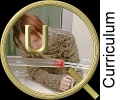
> ACCENT en > UQ 1 Nov Dec 06 Particles in air > C: Information for teachers > Classes Part A
|
|
 |
Part A - Experience of air, experiments with air
In part A we describe air as a perceivable medium which consists of gases but not only of gases.
Requirements:
In chemistry or physics you already spoke about the gaseous state. You discussed air as an example for a mixture of gases.
|
|
Approach:
Speak about ideal pure gases. Discuss the atmosphere and the real air around us.
Integration of the material in this edition:
Unit for 1-2 lessons
Step 1: (preparatory homework) Ask the students to observe the air and to experience it consciously! Ask the students to write down of what air is consisting to their opinion.
Step 2: (lesson) The students shall read a definition of air from an encyclopaedia or lexicon. Please offer a definition which includes only the gaseous components of air.
Ask your students to discuss in which way this definition differs from their observation of the real air and what belongs to the air (possibly in group work).
Step 3: (lesson or homework) The students shall read the texts "fundamentals" and "research" from part A.
Step 4: (lesson!) Carry out the combustion experiment.
Step 5: (homework) Ask the students to answer the questions about the combustion experiments (expectations here). The students may correct and enhance their ideas of air.
Step 6: (lesson) Develop in the classes a comprehensive definition of air which includes besides from the gases also particles and other floating matter. Avoid to speak about "air pollution" in this context.
Objectives
After the introduction of the gaseous state air shall be understood as a mixture of gases in different states. The pupils shall learn to experience the air in their environment with all senses (feeling of wind on the skin, recognition of atmospheric opacity with the eyes, smell of flavours and exhaust gases with the nose).
According to their observation the students shall learn to distinguish the theoretical ideal composition or air and the real composition in the atmosphere.
The students shall become aware that the additional compounds in the air belong to the natural as well as to the human-influenced atmosphere because they are always present even though in changing concentrations.
Methodology
The material aims on a stepwise examination of differences between the theoretical idea of air as a gas and the reality. The power of observation of the students is required.
Most likely the students have to revise their so far understanding of air and the atmosphere. Discuss during the work on this chapter the following three statements and the validity of their causal connection:
- The atmosphere is a shell of air around the world
- Air is a nearly ideal gas
- I can understand the properties of the atmosphere from the properties of ideal gases.
Analyse with the students the problem of this hypothesis.
|
 > ACCENT en > UQ 1 Nov Dec 06 Particles in air > C: Information for teachers > Classes Part A
> ACCENT en > UQ 1 Nov Dec 06 Particles in air > C: Information for teachers > Classes Part A